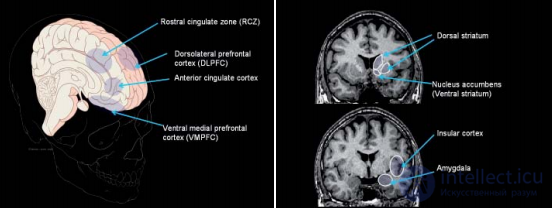Neurobiological studies have demonstrated the existence of several
concurrent neural systems that ensure the process of adopting
solutions and specializing in solving various types of behavioral tasks
(Fig. 3), which in itself is not an amazing fact, because natural selection
constantly testing the performance of neural networks. At the same time, precisely because
highly specialized capabilities of such neuronal systems can be quite
limited, especially in a rapidly changing modern environment. Social history
modern man is disproportionately shorter than the entire previous biological history
A species of Homo sapiens . It is not surprising that the functionality of the nervous system
we are not infinite of a person and cannot always correspond to constantly transforming
modern reality, since most adaptive
In the course of evolution, the capabilities and abilities of the human brain were selected
Serious "environment. For example, the average life expectancy of Englishwomen today
82 years old, and English men 71 years old. At the beginning of the twentieth century, in 1901, the average age of an-
Glychan was equal to 49 and 45 years respectively, and 10 thousand years ago people lived approximately
20 years. It is logical to assume that the previously discussed phenomenon of temporary discounting
temporal discounting (when a person wants to get “all at once” without waiting for
material goods of a remote order) and an increase in life expectancy can
be dramatically related to each other, - modern man is simply not
underestimates the value of the delayed remuneration, since never in its
her evolutionary history did not live so long.
In general, the results of neuroeconomic studies convincingly point to
The fact that the exercise of choice in the decision-making process is due to the work of the
neuronal systems. The automatic involuntary system provides
reaction to changing conditions, but sometimes fails and leads to economically
optimal solutions. This system arose before all other decision-making systems.
often poorly adapted to the realities of modern economic activity.
nosti. Perhaps that is why it became necessary to form an arbitrary
a system that would adjust the activity of involuntary mechanisms. According to
modern neuroeconomic theory to understand the mechanisms of human behavior
ka should take into account the mental automatism of the human irrational
on the one hand, not exaggerating the role of rational mechanisms in decision-making
on the other.
Fig.3. Areas of the brain that play a key role in making decisions:
Rostral cingulate zone (RCZ) is the growing region of the belt cortex.
Dorsolateral prefrontal cortex (DLPFC) - upper frontal cortex.
Anterior cingulate cortex - anterior cingulate region .
Ventral medial prefrontal cortex (VMPFC) - lower medial frontal cortex.
Dorsal striatum - the upper part of the striatum (striatum).
Nucleus accumbens (ventral striatum) - the adjacent nucleus (lower striatum).
Insular cortex - insular cortex.
Amygdala - amygdala

Comments
To leave a comment
NEUROECONOMICS
Terms: NEUROECONOMICS